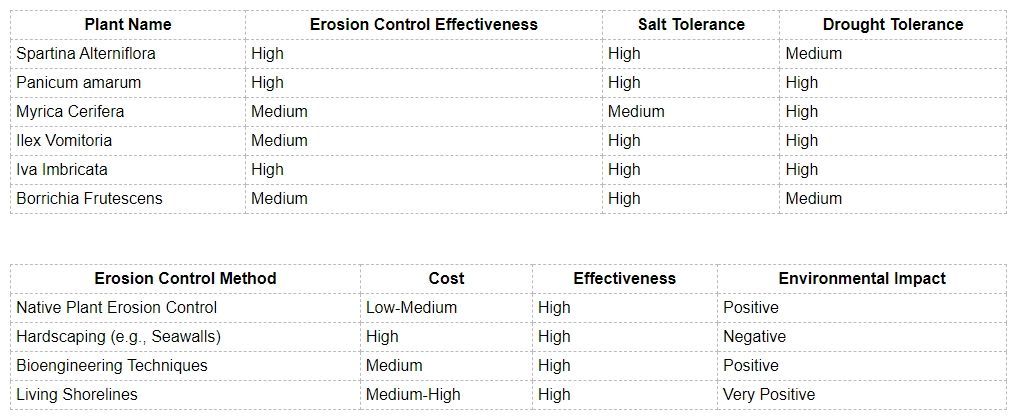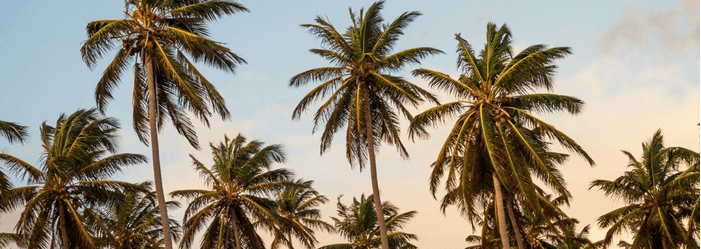Erosion Control Plantings: Saving Charleston's Coast
Key Takeaways
- Native plants are best suited for erosion control in Charleston's coastal environment
- A mix of grasses, shrubs, and trees provides the most effective erosion protection
- Regular maintenance is crucial for the success of erosion control plantings
- Proper plant selection can enhance both soil stability and local biodiversity
- Erosion control plantings offer a natural and aesthetically pleasing alternative to hardscaping
Erosion control plantings are an effective and environmentally friendly way to protect Charleston's coastal areas from soil loss and water damage. By using carefully selected native plants, property owners can stabilize slopes, prevent soil erosion, and maintain the natural beauty of the Lowcountry landscape. This article will guide you through the process of choosing and implementing erosion control plantings in Charleston, South Carolina.
Understanding Coastal Erosion in Charleston
Charleston's unique coastal environment faces constant challenges from wind, waves, and storm surges. The city's proximity to the Atlantic Ocean and its network of tidal creeks and rivers make it particularly vulnerable to erosion. This natural process can threaten both private property and public infrastructure if left unchecked.
The Impact of Climate Change
Climate change has intensified the erosion problem in Charleston. Rising sea levels and more frequent severe storms have increased the rate of coastal erosion. This has made it more important than ever for property owners to take proactive measures to protect their land.
Natural vs. Engineered Solutions
While engineered solutions like seawalls and bulkheads can provide immediate protection, they often come with high costs and potential environmental drawbacks. Erosion control plantings offer a more natural and sustainable alternative that can be just as effective in the long run.
Benefits of Using Plants for Erosion Control
Plants offer several advantages when it comes to erosion control in Charleston's coastal areas. Their root systems help bind soil particles together, reducing the likelihood of erosion. Above ground, plants slow the flow of water and wind, further protecting the soil surface.
Cost-Effective Solution
Compared to hardscaping options, erosion control plantings are often more affordable to install and maintain. They also tend to appreciate in value over time as the plants mature and establish stronger root systems.
Ecosystem Enhancement
Native plants used for erosion control can provide habitat for local wildlife, including birds, butterflies, and beneficial insects. This can help support Charleston's rich biodiversity and contribute to a healthier ecosystem.
Selecting the Right Plants for Charleston's Climate
Choosing the right plants is crucial for successful erosion control in Charleston. Native species are often the best choice as they are already adapted to the local climate and soil conditions.
Salt-Tolerant Species
For areas close to the coast, salt-tolerant plants are essential. These species can withstand salt spray and occasional flooding with saltwater.
Drought-Resistant Options
Charleston's summers can be hot and dry, so plants that can tolerate periods of drought are important for long-term success.
Grasses for Erosion Control
Grasses are often the first line of defense against erosion due to their dense root systems and ability to quickly cover large areas.
Spartina Alterniflora (Smooth Cordgrass)
Smooth cordgrass is a native salt marsh grass that thrives in Charleston's tidal areas. It's excellent for stabilizing shorelines and can tolerate regular flooding.
Panicum Amarum (Bitter Panicum)
Bitter panicum is a hardy grass that does well on coastal dunes. It's drought-tolerant and can help build up sand dunes over time.
Shrubs and Small Trees for Slope Stabilization
Shrubs and small trees can provide deeper root systems for more extensive erosion control, especially on steeper slopes.
Myrica Cerifera (Wax Myrtle)
Wax myrtle is a versatile native shrub that can tolerate both wet and dry conditions. Its extensive root system makes it excellent for stabilizing slopes.
Ilex Vomitoria (Yaupon Holly)
Yaupon holly is a tough, evergreen shrub that can handle salt spray and poor soil conditions. It's a good choice for coastal areas in Charleston.
Ground Covers for Soil Protection
Ground covers can quickly spread to cover bare soil, providing immediate protection against erosion.
Iva Imbricata (Dune Elder)
Dune elder is a low-growing shrub that spreads quickly to form a dense ground cover. It's excellent for stabilizing sandy areas near the coast.
Borrichia Frutescens (Sea Oxeye Daisy)
Sea oxeye daisy is a salt-tolerant ground cover that produces cheerful yellow flowers. It's well-suited for coastal areas and can help prevent sand erosion.
Implementing Erosion Control Plantings
Proper implementation is key to the success of erosion control plantings in Charleston.
Site Preparation
Before planting, it's important to assess the site and prepare the soil. This may involve grading, adding organic matter, or installing temporary erosion control measures.
Planting Techniques
The planting technique will vary depending on the type of plant and the site conditions. Some plants may need to be installed in a specific pattern or density for optimal erosion control.
Maintenance of Erosion Control Plantings
Regular maintenance is crucial for the long-term success of erosion control plantings in Charleston.
Watering and Fertilization
Newly planted areas will need regular watering until they become established. Fertilization may be necessary, but should be done carefully to avoid runoff into waterways.
Weed Control
Controlling weeds is important to allow the desired plants to establish and thrive. This may involve manual removal or carefully applied herbicides.
Combining Plants with Other Erosion Control Methods
In some cases, plants alone may not be sufficient for erosion control in Charleston's challenging coastal environment.
Bioengineering Techniques
Bioengineering techniques combine plants with structural elements like coir logs or brush mattresses to provide immediate erosion protection while plants establish.
Living Shorelines
Living shorelines are a popular approach in Charleston that combines native plants with natural materials like oyster shells to create a stable, ecologically beneficial shoreline.
Case Studies: Successful Erosion Control Projects in Charleston
Several successful erosion control projects in Charleston demonstrate the effectiveness of using plants to combat erosion.
Folly Beach Dune Restoration
This project used native grasses and shrubs to rebuild and stabilize dunes along Folly Beach, providing natural protection against storm surge and erosion.
Isle of Palms Shoreline Management
The Isle of Palms has implemented a comprehensive shoreline management plan that includes native plantings to protect against erosion and enhance wildlife habitat.
Legal Considerations for Erosion Control in Charleston
Before implementing any erosion control measures, it's important to be aware of local regulations and permitting requirements.
Coastal Zone Management Act
Charleston is subject to the South Carolina Coastal Zone Management Act, which regulates activities in coastal areas, including erosion control measures.
Local Ordinances
Many municipalities in the Charleston area have specific ordinances related to erosion control and shoreline management. It's important to check with local authorities before starting any project.
The Role of Professional Assistance
While some erosion control plantings can be done by property owners, professional assistance can be valuable, especially for larger or more complex projects.
Landscape Architects
Landscape architects can provide comprehensive design services that integrate erosion control plantings with other landscape features.
Marine Contractors
For projects along the water's edge, marine contractors with experience in erosion control can provide valuable expertise and implementation services.
Erosion Control Plantings and Property Value
Implementing effective erosion control measures can have a positive impact on property values in Charleston.
Protecting Waterfront Property
By preventing land loss and protecting against storm damage, erosion control plantings can help maintain or increase the value of waterfront properties.
Aesthetic Benefits
Well-designed erosion control plantings can enhance the natural beauty of a property, potentially increasing its aesthetic and market value.
Future Trends in Erosion Control for Charleston
As Charleston continues to face challenges from sea level rise and climate change, new approaches to erosion control are likely to emerge.
Adaptive Management
Adaptive management strategies that can respond to changing conditions over time are becoming increasingly important in Charleston's dynamic coastal environment.
Integration with Green Infrastructure
There's a growing trend towards integrating erosion control plantings with broader green infrastructure initiatives to address multiple environmental challenges simultaneously.
Conclusion
Erosion control plantings offer a sustainable, cost-effective, and environmentally friendly solution for protecting Charleston's coastal areas. By carefully selecting and maintaining native plants suited to local conditions, property owners can help preserve the natural beauty and ecological health of the Lowcountry while protecting their land from the forces of erosion. As Charleston continues to face environmental challenges, these natural solutions will play an increasingly important role in maintaining the city's unique coastal landscape. For more information, you can visit our website or contact us.

- Factors to consider when selecting erosion control plants for Charleston:
- Native to the Lowcountry region
- Salt tolerance for coastal areas
- Drought resistance for summer conditions
- Root system depth and spread
- Growth rate and coverage potential
- Compatibility with existing ecosystem
























































